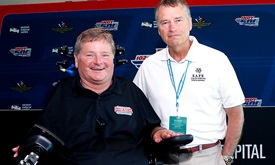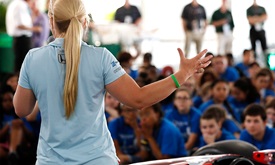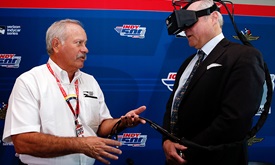You don't need to be Superman to see value of I-PAS concussion evaluation
MAY 17, 2018
I am not right in the head. If you know me, you’re painfully aware of this. If you don’t know me, well, now I have proof. I took a test that (naturally) I didn’t ace.
Thanks to Neuro Kinetics Inc. and I-PAS, a concussion evaluation test implemented by the Verizon IndyCar Series and administered to me on Wednesday, I show some signs of a past brain injury. Nothing serious, apparently, but there’s a trace of derp in the old mainframe.
Perhaps I used a towel as a cape and jumped from the roof of the garage as Superman a few too many times in my youth. Or maybe it was being on the losing end of dodgeball, over and over and over. Or all those years of football. Or that time I fell from a tree and couldn’t breathe right for a week.
More likely, according to Dr. Geoffrey Billows, INDYCAR’s director of medical services, the reading was the result of a minor brain hemorrhage sustained three years ago and caught before it became critical. That type of trauma is something the I-PAS test flags but doesn’t specify.
The test is one more tool in INDYCAR’s aggressive campaign to identify and treat concussions. The tests were cleared by the Federal Drug Administration in March. If a driver shows immediate symptoms of a concussion after a crash – nausea, dizziness, confusion – he or she will take the I-PAS to determine whether a concussion occurred and whether further treatment is necessary.
“It’s like going from a sundial to telling time with an electronic device,” said four-time Verizon IndyCar Series champion Scott Dixon. “Before, it was a pretty basic test. You had blocks and shapes you had to remember. This is more precise. It’s still early in its testing phase, but it’s really cool. If it’s something we can get some hard numbers from and help determine concussions, then it will be very helpful.”
I-PAS stands for I-Portal Portable Assessment System. When you put on the headset, you can’t help but look goofy. It’s a headpiece, black with square corners, that fits over your eyes and stays in place with straps that fit around the back of your head. Drivers call it “concussion goggles.” It’s something like a virtual reality headpiece, but without the fun.
What it offers, though, is far more important than fun. A series of light tracking tests, some of which include audio, record the eyes’ reflexes using USB-3 digital camera technology. The 14 non-invasive OVRT tests (oculomotor, vestibular and reaction time) are linked to a laptop that the test’s administrator uses to determine signs of a concussion.
In my case, it wasn’t that difficult. When asked to arrange a line of lights so they were perfectly vertical, I arranged them to be perfectly horizontal. Nice work, Superman.
Joking aside, I-PAS has enormous potential in treating and possibly preventing a serious issue in all of sports, not just auto racing. Repeated sports-related head trauma can lead to serious issues in later life. CTE – chronic traumatic encephalopathy – results after repeated head trauma. Clumps of protein spread through the brain, destroying brain cells. Most commonly seen in professional football players and soldiers who experience repeated head injuries, CTE has been linked to memory loss, impairment, aggression, dementia and suicide.
Concussions and their aftermath are an issue in racing, as well. After struggling to recover from a concussion and missing much of the 2016 NASCAR season, Dale Earnhardt Jr. retired in 2017. “It’s really hard as a driver to say you’ve got a problem,” Earnhardt said while recovering. “I was sort of scared straight into getting checked out. You can’t scan and see it. Doctors can’t see it.”
The I-PAS test is able to see it. It also has the ability to see past brain injuries and assist with determining drug effectiveness and Parkinson’s disease, among other applications. It has the ability to determine hemispheric dominance – right brain or left brain – as well as eye and hand dominance. But determining concussions is the primary use of the test for INDYCAR’s medical staff.
“It’s like a scar,” said Dr. Terry Trammell, the longtime member of the INDYCAR safety team who currently serves as a safety consultant. “It isn’t that the brain has stopped working, it’s just that the test knows that that pathway has been damaged at some point in the past. You can still score past the test, but the test will say, ‘Hey, this is something different.’ It works on saccades, which is how your eyes move. Whoever is giving the test sees your eyes and the movement. … All of these tests are FDA-approved. They’re specifically approved for the use of diagnosis of a concussion.”
I-PAS isn’t the only tool for INDYCAR’s medical staff to determine and begin treatment of concussions; it’s just the latest tool. Data collection of crashes begins with an earpiece drivers wear that tracks the deceleration of the head during impact. Each car has a black box that collects G-force impact data. And a project is underway to compare drivers who have sustained impacts of at least 50 Gs to determine if there were changes in drivers who may have been concussed but not diagnosed.
This is a profound development in a profound field of study, and INDYCAR is in front of it. Concussions aren’t the mystery they were 10 years ago, but they’re still a mystery. All sports face the effects of head injuries, some more than others. I-PAS is one more step in the path toward understanding.
But the first step? Get off the roof of the garage, Superman.



















